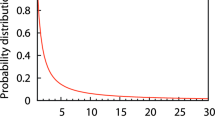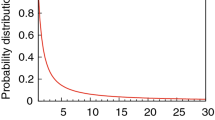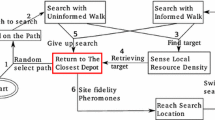Abstract
Creating a robot network to connect the targets while exploring an unknown map is the goal of the path formation issue. It is difficult to maximize the efficiency of exploring a multi-target maze by a robot swarm with limited sensor capabilities. In this study, a novel behavior-based path formation approach (BPFM) that incorporates an artificial potential field and a bio-model inspired by slime mold is proposed for this problem. The robot’s controller can operate more sensibly while using the heuristic term from particle swarm. In order to maintain a dynamic multi-source network, a series of mechanisms and transition rules have been designed for the multi-target maze. Grid maps with obstacle density from sparse to dense are utilized in simulations to compare the proposed method with other algorithms. The results indicate that the performance of collective exploration, which is examined in diverse circumstances, is unexpectedly efficient and robust.

























Similar content being viewed by others
References
Wang T, Huang P, Dong G (2020) Modeling and path planning for persistent surveillance by unmanned ground vehicle. IEEE Trans Autom Sci Eng 18(4):1615–1625. https://doi.org/10.1109/TASE.2020.3013288https://doi.org/10.1109/TASE.2020.3013288
Niroui F, Zhang K, Kashino Z, Nejat G (2019) Deep reinforcement learning robot for search and rescue applications: exploration in unknown cluttered environments. IEEE Robot Autom Lett 4(2):610–617. https://doi.org/10.1109/LRA.2019.2891991
Ramaithitima R, Bhattacharya S (2018) Landmark-based exploration with swarm of resource constrained robots. In: 2018 IEEE international conference on robotics and automation (ICRA), pp 5034–5041. https://doi.org/10.1109/ICRA.2018.8460884
Suryan V, Tokekar P (2020) Learning a spatial field in minimum time with a team of robots. IEEE Trans Robot 36(5):1562–1576. https://doi.org/10.1109/TRO.2020.2994003
Rouček T, Pecka M, Čížek P (2020) DARPA subterranean challenge: multi-robotic exploration of underground environments
Obute SO, Kilby P, Dogar MR, Boyle JH (2022) Swarm foraging under communication and vision uncertainties. IEEE Trans Autom Sci Eng 19(3):1446–1457. https://doi.org/10.1109/TASE.2022.3164044
Nouyan S, Dorigo M (2006) Chain based path formation in swarms of robots. In: Ant colony optimization and swarm intelligence, pp 120–131. https://doi.org/10.1007/11839088_11
Nouyan S, Campo A, Dorigo M (2007) Path formation in a robot swarm. Swarm Intell 2 (1):1–23. https://doi.org/10.1007/s11721-007-0009-6
Coppola M, Guo J, Gill EKA, de Croon GC (2019) Provable self-organizing pattern formation by a swarm of robots with limited knowledge. Swarm Intell 13:59–94. https://doi.org/10.1007/s11721-019-00163-0
Gao C, Zhang X, Yue Z, Wei D (2020) An accelerated physarum solver for network optimization. IEEE Trans Cybern 50(2):765–776. https://doi.org/10.1109/TCYB.2018.2872808
Valdez F (2021) Swarm intelligence: a review of optimization algorithms based on animal behavior. Springer International Publishing, pp 273–298. https://doi.org/10.1007/978-3-030-58728-4_16
Dorigo M, Gambardella LM (1997) Ant colony system: a cooperative learning approach to the traveling salesman problem. IEEE Trans Evol Comput 1:53–66. https://doi.org/10.1109/4235.585892
Ajeil FH, Ibraheem IK, Azar AT, Humaidi AJ (2020) Grid-based mobile robot path planning using aging-based ant colony optimization algorithm in static and dynamic environments. Sensors 20(7):1880. https://doi.org/10.1007/11839088_11
Zang X, Jiang L, Ding B, Fang X (2021) A hybrid ant colony system algorithm for solving the ring star problem. Appl Intell 51:3789–3800. https://doi.org/10.1007/s10489-020-02068-6
Cao L, Ben K, Peng H, Zhang X (2022) Enhancing firefly algorithm with adaptive multi-group mechanism. Appl Intell 52:9795–9815. https://doi.org/10.1007/s10489-021-02766-9
Long Y, Zuo Z, Su Y, Li J, Zhang H (2020) An A*-based bacterial foraging optimisation algorithm for global path planning of unmanned surface vehicles. J Navig 73(6):1247–1262. https://doi.org/10.1017/S0373463320000247
Shao S, Peng Y, He C, Du Y (2019) Efficient path planning for uav formation via comprehensively improved particle swarm optimization. ISA transactions. https://doi.org/10.1016/j.isatra.2019.08.018
Lu Q, Hecker JP, Moses ME (2016) The MPFA: a multiple-place foraging algorithm for biologically-inspired robot swarms. In: 2016 IEEE/RSJ international conference on intelligent robots and systems (IROS), pp 3815–3821 https://doi.org/10.1109/IROS.2016.7759561
Lu Q, Hecker JP, Moses ME (2018) Multiple-place swarm foraging with dynamic depots. Auton Robot 42:909–926. https://doi.org/10.1016/j.swevo.2021.100843
Lee D, Lu Q, Au TC (2021) Multiple-place swarm foraging with dynamic robot chains. In: 2021 IEEE international conference on robotics and automation (ICRA), pp 11337–11342. https://doi.org/10.1109/ICRA48506.2021.9561124
Morgan S, Hereford JM (2020) Path formation using a robot swarm with limited sensing capabilities. In: 2020 SoutheastCon, pp 1–6. https://doi.org/10.1109/SoutheastCon44009.2020.9249651
Lee D, Lu Q, Au TC (2022) Dynamic robot chain networks for swarm foraging. In: 2022 IEEE international conference on robotics and automation (ICRA), pp 4965–4971. https://doi.org/10.1109/ICRA46639.2022.9811625
Jiang L, Huang H, Ding Z (2020) Path planning for intelligent robots based on deep Q-learning with experience replay and heuristic knowledge. IEEE/CAA Journal of Automatica Sinica 7(4):1179–1189. https://doi.org/10.1109/JAS.2019.1911732
Llenas AF, Talamali MS, Xu X, Marshall JAR, Reina A (2018) Quality-sensitive foraging by a robot swarm through virtual pheromone trails. In: Swarm intelligence, pp 135–149. https://doi.org/10.1007/978-3-030-00533-7_11
Patle BK, GB L, Pandey A, Parhi DR, Jagadeesh A (2019) A review: on path planning strategies for navigation of mobile robot. Defence Technology. https://doi.org/10.1016/J.DT.2019.04.011
Lu Q, Fricke GM, Ericksen J, Moses ME (2020) Swarm foraging review: closing the gap between proof and practice. Curr Robot Rep 1:215–225. https://doi.org/10.1007/s43154-020-00018-1
Sperati V, Trianni V, Nolfi S (2011) Self-organised path formation in a swarm of robots. Swarm Intell 5:97–119. https://doi.org/10.1007/s11721-011-0055-y
Hiraga M, Yasuda T, Ohkura K (2018) Graduate School of Engineering H, Graduate School of Science and Engineering, University of Toyama Evolutionary acquisition of autonomous specialization in a path-formation task of a robotic swarm. J Adv Comput Intell Intell Inform 22(5):621–628. https://doi.org/10.20965/jaciii.2018.p0621
Damani M, Luo Z, Wenzel E, Sartoretti G (2021) PRIMAL2: pathfinding via reinforcement and imitation multi-agent learning-lifelong. IEEE Robot Autom Lett 6 (2):2666–2673. https://doi.org/10.1109/LRA.2021.3062803
Ray S, Valentini G, Shah PC, Haque A, Reid CR, Weber GF, Garnier S (2019) Information transfer during food choice in the slime mold physarum polycephalum. Frontiers in Ecology and Evolution. https://doi.org/10.3389/fevo.2019.00067
Nakagaki T, Yamada H, Tóth Á (2000) Intelligence: maze-solving by an amoeboid organism. Nature 407:470–470. https://doi.org/10.1038/35035159
Tero A, Takagi S, Saigusa T, Ito K, Bebber DP, Fricker MD, Yumiki K, Kobayashi R, Nakagaki T (2010) Rules for biologically inspired adaptive network design. Science 327:439–442. https://doi.org/10.1126/science.1177894
Gao C, Liu C, Schenz D, Li X, Zhang Z, Jusup M, Wang Z, Beekman M, Nakagaki T (2019) Does being multi-headed make you better at solving problems? A survey of physarum-based models and computations. Phys Life Rev 29:1–26. https://doi.org/10.1016/j.plrev.2018.05.002
Tero A, Kobayashi R, Nakagaki T (2007) A mathematical model for adaptive transport network in path finding by true slime mold. J Theor Biol 244(4):553–64. https://doi.org/10.1016/J.JTBI.2006.07.015
Jones J (2015) A morphological adaptation approach to path planning inspired by slime mould. Int J Gen Syst 44(3):279–291. https://doi.org/10.1080/03081079.2014.997526
Luo Y, Guo J, Lao Z, Zhang S, Yan X (2021) Swarm robot exploration strategy for path formation tasks inspired by physarum polycephalum. Complexity 2021:1–17. https://doi.org/10.1155/2021/6698421
Jones J, Safonov A (2018) Slime mould inspired models for path planning: collective and structural approaches. Springer International Publishing, pp 293–327. https://doi.org/10.1007/978-3-319-77510-4_11https://doi.org/10.1007/978-3-319-77510-4_11
Poli R, Kennedy J, Blackwell TM (2007) Particle swarm optimization. Swarm Intell 1:33–57. https://doi.org/10.1007/s11721-007-0002-0
Li G, Wang W, Zhang W, Wang Z, Tu H, You W (2021) Grid search based multi-population particle swarm optimization algorithm for multimodal multi-objective optimization. Swarm Evol Comput 62:100843. https://doi.org/10.1016/j.swevo.2021.100843
Nasir J, Islam F, Malik U, Ayaz Y, Hasan O, Khan M, Muhammad MS (2013) RRT*-SMART: a rapid convergence implementation of RRT*. Int J Adv Robot Syst 10(7):299. https://doi.org/10.5772/56718
Acknowledgements
This work was not supported by any foundations.
Author information
Authors and Affiliations
Corresponding author
Ethics declarations
Conflict of Interests
The authors declare that they have no conflict of interest.
Additional information
Publisher’s note
Springer Nature remains neutral with regard to jurisdictional claims in published maps and institutional affiliations.
Haichao Liu and Runwen Zhu contributed equally to this work.
Rights and permissions
Springer Nature or its licensor (e.g. a society or other partner) holds exclusive rights to this article under a publishing agreement with the author(s) or other rightsholder(s); author self-archiving of the accepted manuscript version of this article is solely governed by the terms of such publishing agreement and applicable law.
About this article
Cite this article
Zhao, Y., Qu, Z., Liu, H. et al. Bio-inspired robot swarm path formation with local sensor scope. Appl Intell 53, 17310–17326 (2023). https://doi.org/10.1007/s10489-022-04356-9
Accepted:
Published:
Issue Date:
DOI: https://doi.org/10.1007/s10489-022-04356-9




